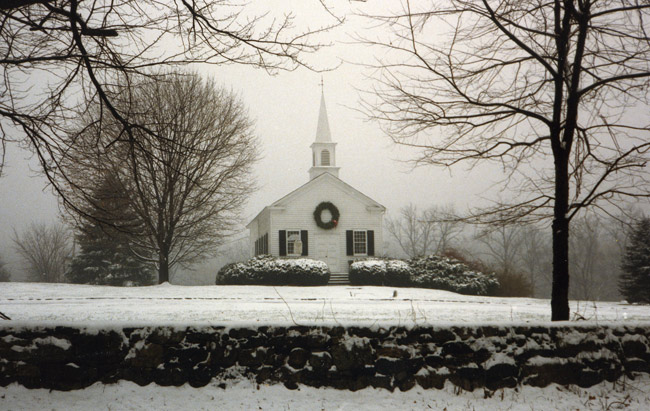
Modest in size, but of great historic interest, the white clapboard Dingletown Church on Stanwich Road was built at the corner of Dingletown Road in 1845. The name, Dingletown, is believed to refer to the tinkling of the bells worn by the dairy cows that grazed in the surrounding pasturelands of the day.
Earlier in 1839, Henry Lockwood had sold land for the church to James Jarman, William Ferris, David Johns and Gideon Lounsbury, retaining a temporary interest for himself as one of the church founders.
The Lounsbury family had been in America since the early-to-mid-17th century, as had the Lockwoods, who arrived in Watertown, Mass. in 1630, after sailing on the Arabella from England’s Isle of Wight to Cape Ann with Governor Winthrop’s fleet. The Lockwood family can trace its roots at least as far back as 1390 and Baron Roger de Lockwood.
 The group, in turn, sold the land to the Eastern Conference of the Methodist Protestant Church¸ the Methodist Protestant Society, the Horseneck Society of the Church and the Methodist Protestant Church at North Cos Cob. The building is thought to be the oldest frame church throughout Greenwich.
The group, in turn, sold the land to the Eastern Conference of the Methodist Protestant Church¸ the Methodist Protestant Society, the Horseneck Society of the Church and the Methodist Protestant Church at North Cos Cob. The building is thought to be the oldest frame church throughout Greenwich.
Even earlier¸ the congregation, formed in 1830, had been part of the Bedford Society, meeting around and about, probably at the homes of various members. A circuit rider, a clergyman who was responsible for two, or more rural parishes, tended to their spiritual needs.
In 1845, when the church opened, attendance at the church for Sunday services, lasting all day were compulsory, with fines levied for non-compliance.
As late as 1921, the one-and-a-half story church was still heated by a pot-bellied stove and lit by candles sitting in pewter sconces, along with oil lamps.
After the death of the minister, Dr. Alfred Lunning, in 1935, the church was closed, and the building was purchased by Dr. William Darrach, a neighbor, in order to preserve the historic landmark. During WWII, when gasoline was rationed, the church was reopened, and services began once again. As well, the church, which seats 80 to 100, became non-denominational and today is open to residents of all religious faiths.
Dr. Darrach was a professor of clinical surgery at Columbia’s College of Physicians and Surgeons of which he was a graduate.
Nearby was a carriage barn and a manse, or parish house, that were church property¸ a schoolhouse as well as a blacksmith’s that was part of a general store.

The church of one-and-a-half stories has a gable front and twelve-over-twelve shuttered windows run around the exterior. The rear elevation has two windows and a central fanlight, and a double, paneled door at the front welcomes visitors. Unpeeled logs formed the floor supports, and bent saplings the ceiling.
Inside is a barrel-vaulted ceiling and a flushboard wainscot extends around the building. A central aisle, with pews on either side, divides the nave, and a turned balustrade defines the chancel with its central paneled pulpit.
Behind the church is a circular memorial garden with a low rock wall and wooden benches, where services are occasionally conducted.
The articles were featured in the greenwich.patch.com throughout 2012.

